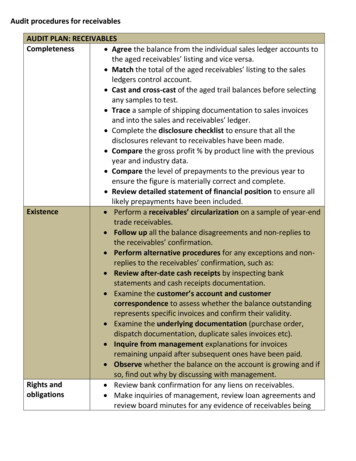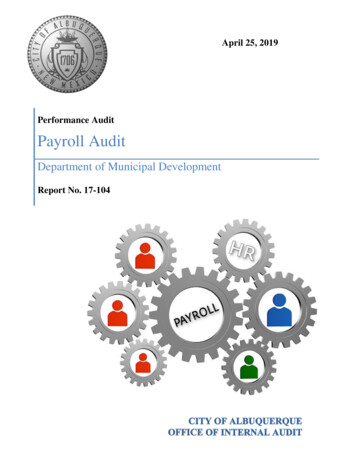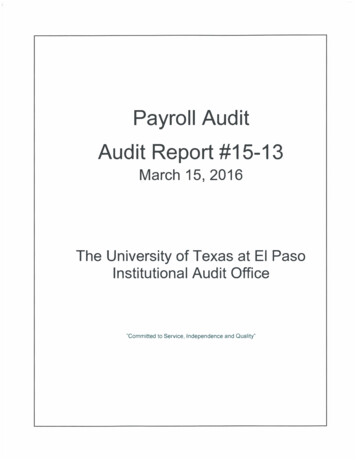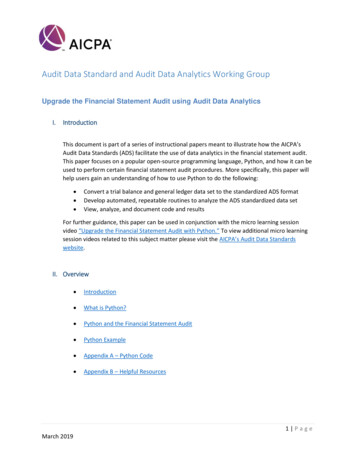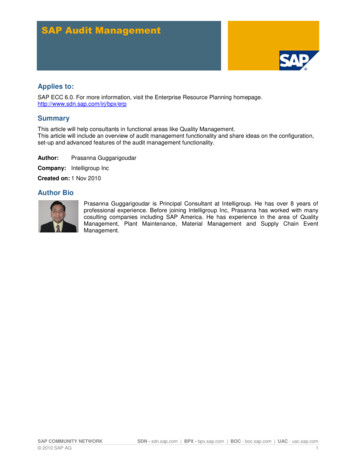
Transcription
SAP Audit ManagementApplies to:SAP ECC 6.0. For more information, visit the Enterprise Resource Planning This article will help consultants in functional areas like Quality Management.This article will include an overview of audit management functionality and share ideas on the configuration,set-up and advanced features of the audit management functionality.Author:Prasanna GuggarigoudarCompany: Intelligroup IncCreated on: 1 Nov 2010Author BioPrasanna Guggarigoudar is Principal Consultant at Intelligroup. He has over 8 years ofprofessional experience. Before joining Intelligroup Inc, Prasanna has worked with manycosulting companies including SAP America. He has experience in the area of QualityManagement, Plant Maintenance, Material Management and Supply Chain EventManagement.SAP COMMUNITY NETWORK 2010 SAP AGSDN - sdn.sap.com BPX - bpx.sap.com BOC - boc.sap.com UAC - uac.sap.com1
SAP Audit ManagementTable of ContentsIntroduction . 3Audit Management Phases: . 3Audit Management life cycle: . 4Audit Management Data Objects: . 5Audit Execution: . 6Roles in Audit Management: . 6Audit Management configuration: . 7Related Content . 10Disclaimer and Liability Notice . 11SAP COMMUNITY NETWORK 2010 SAP AGSDN - sdn.sap.com BPX - bpx.sap.com BOC - boc.sap.com UAC - uac.sap.com2
SAP Audit ManagementIntroductionSAP Audit Management is tool that supports performing any kind of audit. Audit management facilitatessystematic examination to determine whether or not an object meets predefined requirements. It providesability to define question lists and evaluate the results and document.Audit Management manages elements of the planning phase, the execution of the audit, the evaluation ofthe results and the management of corrective actions.This solution is applicable across nearly all industry sectorsArea of Application:Audit management can be used in multiple application areas as listed belowQuality Management AuditsProcess AuditsProduct AuditsEnvironmental AuditsSecurity and Safety Management AuditsAudit Management Phases:Different phases of Audit management can be represent asAudit PlanningAuditingAudit ValuationCorrective and Preventive ActionEvaluationAudit Planning involves determining general questions by which Audit will be performed depending onrelevant standards. These questions define the criteria for Audit execution.Planning of the audit program involves determination of partners, date of the audits and individual questionlist.Audit processing involves the actual execution of Audit. It involves Inviting partners or participants, Releasingthe audit, Examining the audit object with regard to the question list and Recording the findings against eachquestion.Audit Valuation involves valuating findings of question or the recorded findings of Audit processing. It alsoinvolves assessment of the audit object, audit report (interim report, final report, and signature)Subsequent stepsSAP COMMUNITY NETWORK 2010 SAP AGSDN - sdn.sap.com BPX - bpx.sap.com BOC - boc.sap.com UAC - uac.sap.com3
SAP Audit ManagementDetermining a subsequent audit, if necessaryDetermining corrective and preventive actions and the persons responsible for these actionsMonitoring the subsequent steps and the effectiveness of all actionsEvaluationsOverview of all audits or audit objects, or of selected groups of audits and audit objectsOverview of all actions or selected groups of findings and actionsAnalyses of audit results and actions (Pareto, trend, benchmark)Feedback of results to audit planningAudit Management life cycle:SAP COMMUNITY NETWORK 2010 SAP AGSDN - sdn.sap.com BPX - bpx.sap.com BOC - boc.sap.com UAC - uac.sap.com4
SAP Audit ManagementAudit Management Data Objects:Audit management Question lists are used to store recurring audit questions or audit criteria according towhich the audits are executed. Audit can have multiple question lists. Questions lists are part of master datarequired for Audit management and represent the major percent of master data.Hierarchy profiles can be used in question lists. The hierarchy profile determines the hierarchy levels thatexist, and level at which questions can be assigned, and the levels at which valuations can be performed.Question list can also be associated with a priority, a weighting, and a valuation proposal.System allows loading of existing question lists from Excel files into the system, and export question listsfrom the system as an Excel file.Audit plans are used to group audits with similar properties together in a hierarchical structure. You can, forexample, create monthly/yearly plans for audits, or group audits together according to operational area.Each audit plan can contain several subordinate audit plans. Audit plan can be exported using an interface toMS Project.Audit is used to describe the audit type, the audit trigger, and the audit object. Audit parameters can becustomized. The definition of audit objects enables to analyze comparable audit processes for best practicesor trends.The actual execution of an audit can be triggered in couple of ways, either by the persons involved in theaudit, or by the person responsible for the audit. Notification function can be used to allow the personresponsible for the audit to send invitations to the relevant partners.Corrective or Preventive actions can be created for inadmissible deviations, dangers, or potential forimprovements to audit question list. Name of the partner responsible for execution, planned dates can bespecified. Actual execution dates, completion status can also be recorded.The actual completion of an action can be triggered either by the person responsible for the audit, or by theperson responsible for the action.A notification function allows the person responsible for the audit to send instructions, reminders or warningsto the relevant partners.External partners can also be involved in corrective actions and have access to all information they requireand to all processing functions that they are allowed to execute for actions via the Internet and the Webinterface (Web-enabled collaboration)SAP COMMUNITY NETWORK 2010 SAP AGSDN - sdn.sap.com BPX - bpx.sap.com BOC - boc.sap.com UAC - uac.sap.com5
SAP Audit ManagementAudit Execution:Audit execution involves questioning and documentation. Once the questioning is completed, the findings arerecorded in pre-printed shop papers. System also provides feasibility to record on mobile devices. Theserecords can then be transfer to SAP. Then the audit object is valuated.In the question list a valuation profile will be pre-assigned to each item that can be evaluated. This valuationprofile controls the valuation of the relevant items (question or hierarchy level).Valuation can be qualitative (for example, Good, okay, or Poor), or quantitative (for example, in percent, ordegree of deviation). Score are associated with Qualitative valuation levelsAt this stage preliminary audit report can be printed. This report will be used to discuss deviations, actions toeliminate these deviations, and the overall result of the audit with Shop representatives.Normally, both the auditor and the audited party sign the audit report. This report will be scanned and loadedinto system. Digital signature can also be implemented for Audit management.Roles in Audit Management:Many standard roles are defined in audit management; additional roles can be defined in customizing.Person Responsible:In audit management, a person will be responsible for each audit plan, question list, and/orcorrective/preventive action. You can assign different people to each of these components.The person responsible for the annual audit plan interacts with lead auditors and creates an annual auditplan. He or she will be responsible for defining the audit type, audited partner and release of audit plan.The person responsible for the question list will create a question list, on the basis of which the plannedaudits are to be executed. Person responsible for Question list may be different from the person responsiblefor Audit plan.Approver:The approver is responsible for the approval of an audit component. From internal control and regulationsrequirement, Approver will be a different person than the Person responsible.Auditor:The auditors execute the actual audit.Lead Auditor:Lead auditors are responsible for the execution of the audits assigned to them. They confirm the plannedaudit dates with the audit planners and inform them of any date changes. Lead auditors do not execute manyaudits during the year. They also compile the questions for the audits using the question lists.Person Responsible for Area:SAP COMMUNITY NETWORK 2010 SAP AGSDN - sdn.sap.com BPX - bpx.sap.com BOC - boc.sap.com UAC - uac.sap.com6
SAP Audit ManagementThe person responsible for the area is the contact person for the audit in the audited area. All of thequestions, problems, and corrective/preventive actions related to the audit are discussed with, andreconciled by the person responsible for the area.Person Responsible for Actions:The person responsible for actions ensures the correct and timely execution of an action (corrective orpreventive action).Participants:The participants are all the people involved in an audit.Interested Parties:Interested parties are all the people who have an interest in the audit.Audit Management configuration:Question lists are the bases for Audit Management. These questions lists are used in audit management aswell as other applications. Question list configuration is specified in following screen.Under question lists, the hierarchical structure of question lists and the hierarchy levels at which valuationsare performed is defined. Question list profiles can be subdivided into several hierarchy levels. Questionscan be defined for all hierarchy levels, but valuations are only possible for predefined levels.Valuation profile determines whether the valuation is to be qualitative (coded) or quantitative.SAP COMMUNITY NETWORK 2010 SAP AGSDN - sdn.sap.com BPX - bpx.sap.com BOC - boc.sap.com UAC - uac.sap.com7
SAP Audit ManagementFor each qualitative valuation profile, codes are defined and the optimum and minimum points determined.And for each quantitative valuation profile, scale area, the scale increments are defined.Under Partner function, the roles that are available in the system for the partners involved in the audit aredetermined.Audit Ratings are defined under “Rating Profiles”. Multiple Rating Profiles can be used in Audit execution.SAP COMMUNITY NETWORK 2010 SAP AGSDN - sdn.sap.com BPX - bpx.sap.com BOC - boc.sap.com UAC - uac.sap.com8
SAP Audit ManagementSAP COMMUNITY NETWORK 2010 SAP AGSDN - sdn.sap.com BPX - bpx.sap.com BOC - boc.sap.com UAC - uac.sap.com9
SAP Audit ManagementRelated Content Audit Management details on www.help.sap.comQuality Management details on www.help.sap.comSDN Article “U.S. FDA Title 21 CFR Part 11 Compliance Assessment of SAP NetWeaver AuditManagement Functionality”SDN Article “Collaboration Across the Product Life Cycle Ensuring Performance, Quality andContinuous Innovation”SAP COMMUNITY NETWORK 2010 SAP AGSDN - sdn.sap.com BPX - bpx.sap.com BOC - boc.sap.com UAC - uac.sap.com10
SAP Audit ManagementDisclaimer and Liability NoticeThis document may discuss sample coding or other information that does not include SAP official interfaces and therefore is notsupported by SAP. Changes made based on this information are not supported and can be overwritten during an upgrade.SAP will not be held liable for any damages caused by using or misusing the information, code or methods suggested in this document,and anyone using these methods does so at his/her own risk.SAP offers no guarantees and assumes no responsibility or liability of any type with respect to the content of this technical article orcode sample, including any liability resulting from incompatibility between the content within this document and the materials andservices offered by SAP. You agree that you will not hold, or seek to hold, SAP responsible or liable with respect to the content of thisdocument.SAP COMMUNITY NETWORK 2010 SAP AGSDN - sdn.sap.com BPX - bpx.sap.com BOC - boc.sap.com UAC - uac.sap.com11
SAP Audit Management is tool that supports performing any kind of audit. Audit management facilitates Audit management facilitates systematic examination to determine whether or not an object meets predefined requirements.File Size: 313KBPage Count: 11





